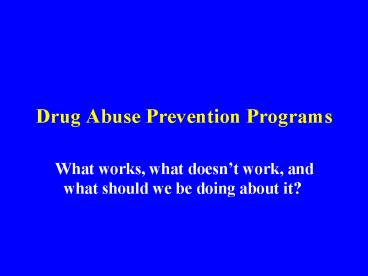Drug Abuse Prevention Programs - PowerPoint PPT Presentation
1 / 20
Title:
Drug Abuse Prevention Programs
Description:
Drug Abuse Prevention Programs. What works, what doesn't work, and what should we ... 10 year follow-ups show no Differences in Use, attitude, or self-esteem ... – PowerPoint PPT presentation
Number of Views:48
Avg rating:3.0/5.0
Title: Drug Abuse Prevention Programs
1
Drug Abuse Prevention Programs
- What works, what doesnt work, and what should
we be doing about it?
2
Types of Prevention Programs
- Universal Prevention
- General message applicable to all in an audience.
- Targeted Populations
- Focusing efforts on groups who may be at-risk.
- Indicated Programs
- Focusing efforts on individuals who may be
at-risk or who have used in the past.
3
Levels of Prevention Programs
- Primary Prevention
- Goal Delay/Prevent the onset of Drug Use by
individuals with little or no previous
experience. - Secondary Prevention
- Goal Reduce the extent of drug use in
individuals who have some drug exposure - Tertiary Prevention
- Goal Relapse Prevention / Treatment Maintenance
4
Goals of Prevention Programs
- Prevent the use of drugs in society.
- Delay the first incidence of drug use.
- Reduce the quantity and frequency of use when it
does occur. - Teach harm-reduction strategies for current
users. - Provide a positive environment consistent with,
drug-free growth personal development.
5
Settings of Prevention Programs
- Family / Parents (Strongest Influence)
- School Based Programs
- Community Based Programs
6
Prevention Approaches with Poor Results
- Reducing the Drug Supply / Availability
- Punitive Measures
- Scare Tactics Negative Education
- Exaggerated or Inaccurate
- Objective Information Approaches
- Low Risk vs. High Risk
- Promotional Campaigns / Materials
- Self-Esteem / Affect Education
7
DARE Program
- Best Known Prevention Program in US
- Used now on International Level
- Public Relations Success
- Visibility equals Success
- Criticisms
- Attitudes Change but not Behavior
- 10 year follow-ups show no Differences in Use,
attitude, or self-esteem - Response 3 Levels of DARE
- Results Inconclusive
8
Factors Influencing Drug Use
- Risk Factors Elements increasing likelihood of
involvement with drugs. - Protective Factors Elements decreasing
likelihood of involvement with drugs and reducing
impact of risk factors - Resiliency Ability to resist negative impact of
risk factors Usually through positive impact of
protective factors
9
Risk Factor Domains (Sources)
- Community
- Family
- School
- Individual / Peer
10
Risk Factor Examples
- Psychosocial Nonconformity (Deviant Subcultures)
- Poor school attendance
- Easy access to drugs.
- Depression
- Alcohol before Age 12
- Adults with Drug Problems in life
- Peer approval
- Number of Drug Using Friends
- Low educational aspirations
11
Protective Factors
- Individual Characteristics
- Gender
- Temperament
- Positive Social Orientation
- Intelligence
- Bonding (3)
- Opportunities that are meaningful, responsible,
significant - Skills
- Recognition
- Healthy Beliefs
- Clear Standards
12
Elements of Comprehensive Prevention Programs
- Information Dissemination (one-way)
- Prevention Education (interactive)
- Alternative Activities
- Community-based Processes
- Environmental Approaches
- Problem Identification Referral
13
Components of Effective Prevention Programs
- Life Skills Training Includes
- Cognitive / Educational Component
- Present consequences vs. future consequences
- Peer Refusal Skills
- How to say no.
- Anxiety and Stress Reduction
- Social Skills Decision Making Skills
- Self-Directed Behavior Change
- (Goal setting)
14
Community Based Programs
- Alternative-Behaviors Programs
- Building relationships with positive role models.
- Project STAR
- School Based Component Middle Junior HS
- Parental Involvement in STAR components
- Health Policy Change Component
- Drug Free Sites, Enforcement of Age Limits
15
Sources of Community Support
- Schools
- Religious/Volunteer Organizations
- Industry
- Health Care Providers
- Law Enforcement
- Community Government
- Youth Organizations
16
Role(s) of Mass Media
- Positive Influences
- Partnership for Drug Free America
- The TRUTH
- Responsible Drinking Campaigns
- Other Portrayals
- MTV, TLC, HDC
- Negative Influences
- Movies
- Television
- Music
- Public Role Models
- Advertising
- Compare Exposure Times
17
Developmental Assets Approaches
- Developmental Assets Building positive
relationships, opportunities, competencies,
values, and self-perceptions that youth need to
succeed. Building blocks producing healthy,
principled, caring, productive youths. - Learn more at http//search-institute.org
18
Developmental Asset Domains
- External Assets
- Support
- Empowerment
- Boundaries and Expectations
- Constructive Use of Time
- Internal Assets
- Commitment to Learning
- Positive Values
- Social Competencies
- Positive Identity
19
Risk Behavior of 6-12th Graders as a Function of
Developmental Assets
20
How are we doing?Total Sample 19.3
- By Grade
- 6th 23.1
- 7th 21.1
- 8th 19.6
- 9th 18.3
- 10th 17.8
- 11th 18.1
- 12th 18.3
- By Gender
- Female 20.7
- Male 17.8
- Total Sample
- 0-10 Assets 15
- 11-20 Assets 41
- 21-30 Assets 35
- 31-40 Assets 9































